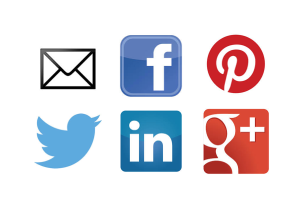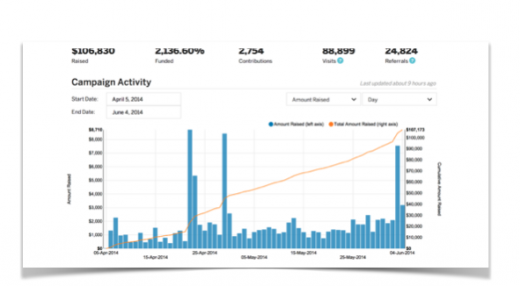
Johnathan Leow is the author of “The Crowdfunded Kit.” This post originally appeared on Crowdfund Insider.
If there’s one big lesson about crowdfunding I’ve learnt in the past eight months, it is that pre-launch marketing can make or break your campaign. I’ve gone from knowing next to nothing about crowdfunding, to running a successful Indiegogo campaign at a previous startup that raised $106,830.
Allow me to share with you our story.
When we launched Duet on April 5, we had no idea what to expect. Could we even cross $5,000? Would backers like our product? All these fears lurked in my mind as I clicked the ‘Launch Campaign’ button.
The first day saw $1,323 in orders… orders that came mainly from our own personal networks. Then day 2 saw a spike of $2,263 raised. This was driven mainly by orders from our email list.
Sales dipped a little on the third day, and continued consistently with about $1,000 raised per day. By day 4, we had already crossed the $5,000 mark, and we celebrated! And backers kept pouring in.
Then on April 22, SlashGear released an article about Duet, and that article alone brought in over $14,000 the next two days. Sales then increased consistently at approximately $1,500 over the following days.
A second mysterious surge of traffic brought in $11,000 on April 29. We later discovered that we had made it for a feature in the Indiegogo newsletter!
For much of the other weeks, sales remained steady, and towards the end of the campaign, we experienced another surge of $10,000. This was because we we were featured on page 1 of Technology category, and also ‘Projects Ending Soon.’
What most people don’t know, is that behind the scenes of these figures were five months of hard work day in and day out, slowly building up our audience base.
Now, let’s talk about you
 A sure recipe for failure made by many crowdfunding campaigns is to invest lots of time into making the most amazing kick-ass videos and rewards… only to launch their campaign with a couple of Facebook and Twitter shares.
A sure recipe for failure made by many crowdfunding campaigns is to invest lots of time into making the most amazing kick-ass videos and rewards… only to launch their campaign with a couple of Facebook and Twitter shares.
No wonder they start going around midway through the campaign to beg for funds.
But you’re different, because you understand that:
“The success of any crowdfunding campaign lies in your traffic generation strategy long before you launch.”
According to Kickstarter’s stats, only 43 percent of projects meet their funding goals. A sobering 12 percent do not even receive a single pledge.
Some of these projects are really promising, and deserve to be uber-funded, simply because the market doesn’t know that they exist.
With over 9,000 projects running at any point in time on Kickstarter, the competition is more intense than before. So knowing how to drive traffic to your crowdfunding page is a basic, absolute must-have skill. Otherwise, you will find yourself struggling to raise the necessary capital to get your project off the ground.
Here’s how:
Build your audience long before you launch
At the very least, do it at least five months before.
There is a secret that successful crowdfunding campaigns have got right. It’s the reason why some projects get funded well beyond their funding goal, while others languish in oblivion with barely a single pledge.
It is the power of leverage. More specifically, you’ll want to leverage Kickstarter or Indiegogo’s vast audience base to drive traffic.
Kickstarter and Indiegogo are traffic amplifiers. If your project demonstrates that it is able to do a good job raising funds, both of these crowdfunding titans will generously help you to amplify the reach of your project.
Conversely, if your project shows that it is not able to raise funds, then the opposite is true: they will not amplify the reach of your project.
How do both crowdfunding platforms amplify a successful project’s reach? By pushing your project up the category rankings, and if they really like you, they’ll feature your project in their weekly newsletter. And more exposure means more pledges.
This is the Holy Grail of crowdfunding that you should aim to unlock. Which is why you’ll need to first build your audience (lots of them), way before you actually launch. And you’ll need sufficient time to do it.
Next: So, how do you actually build an audience?
But how do you actually go about building an audience?
Let’s start with some basic steps. Most of these were the same steps that I took to build a traffic generation strategy for a crowdfunding campaign at my previous company. Other steps I’ve listed them here as I learnt along the way.
Step One: Start with your target customers
List down the specific segments of people that you are targeting at. The trick here is to not be too general, yet not too narrowly specific with describing these customers.
Let’s say you have a innovative idea for takeaway lunch box meals. People who like to eat is too broad a category, while people who like to eat only spaghetti bolognese with beef is too narrow. White collar workers who work in the city, and takeaway their lunches daily from fast food chains sounds much better.
Then you’ll need to make educated guesses to find out what their biggest problems are, and what do they need the most. I’ve found that it helps tremendously to develop customer personas, which are fictitious models of your target customer.
A quick and simple way to do this is to go to the streets and ask 10 people who fit your target audience profile. If they bring up the same problems that you guessed, and are actively looking for solutions, you have a winning campaign.
You get the idea.
Step Two: Make a simple landing page to capture email leads
This was Duet’s landing page on Launchrock, way before it launched. To be honest, the formatting sucked, and it wasn’t impressive at all. But this landing page was good enough to capture over 400 qualified email leads.
You really don’t need to design a super-classy landing page. Just a simple and eye-catching one, with a perk thrown in, will do.
The money is really in the email list. So you’ll want to find a way to encourage people to sign up for your mailing list. There are many services out there that can help do this for you, but my personal favorites are MailChimp and Nathan Barry’s ConvertKit.
MailChimp is free for the first 2,000 subscribers, whereas ConvertKit is very simple to use, and seamlessly integrates beautiful landing pages with your email list. Make sure you offer something in exchange for people to sign up. I find that giving away an e-book, or a lucky draw contest for people to win early versions of your product, work best.
Step Three: Setup a blog
Don’t settle for a cheap looking weebly.com blog, but a real, decent looking one. At the day’s end, first impressions do count, and you want people to trust that they are dealing with you, a legit entity.
WordPress, and Ghost are highly recommended blogging platforms. Invest some money into getting a good domain name, web hosting, and a premium template.
There’s no excuse that it’s hard to setup, because both blogging platforms are made to be so simple to set up, you can start blogging within five minutes.
Step Four: Begin with 10 people in your networks who might need it most
This is the fastest and simplest method you can start with to get traffic.
Think about your product for a moment. What value does it offer, and who could benefit most from it? Think specifically of names in your immediate network. It could be your friends, or acquaintances who might most likely need it. Still can’t think of 10? Stretch further to people you met at an event, and ex-colleague, or even a friend of a friend you might know.
Then write them down:
1.____________________________________
2.____________________________________
3.____________________________________
4.____________________________________
5.____________________________________
6.____________________________________
7.____________________________________
8.____________________________________
9.____________________________________
10.____________________________________
Note: Listing these 10 names is super important. Do not skip it!
Once you’ve listed them, email and reach out to every single person on your list and share with them the link to your landing page.
Step Five: Hang out in your target audience’s online communities
Long ago in the ancient Middle East, guys who were looking for prospective, future wives would often hang out at the common town well in the evening. That’s because the evenings were the time of the day when the unmarried girls in the village would come out to draw water for their families and livestock. And what better place to chat up a girl, then when she was drawing water?
You can begin by asking the following questions:
- Which online sites do my audience often read?
- What search terms do they use?
- Which social media sites do they hang out at?
At the very least, you should at least join all relevant Facebook, LinkedIn, Twitter and Google+ communities of your target audience. Then explore related forums that they hang out in.
You can do this quickly by going to Google and typing in:
forum:niche
So for example, for the crowdfunding niche, you’d type in:
forum:crowdfunding (make sure you type in “forum”, and not “forums”).
Then register for an account in those forums, and focus on making yourself incredibly useful. Don’t immediately look to promote your product’s landing page, but learn to listen and help other people out with their problems first. Remember, its always better to give than to receive.
Step Six: Submit your landing page to link sites
The next easy thing to do is to submit your landing page to link voting or weekly email lists. Even if your post doesn’t hit the home page of Hacker News, it may still pick up a little traffic from being on the new page (I’ve had up to 30 subscribers just from that).
You can also try contacting the owners who run weekly mailing lists by topic, such as the iOS Dev Weekly newsletter run by Dave Verwer.
Find the sites most relevant to your topic. Here are link sites you can start with:
- Hacker News
- Reddit (there are subreddits on nearly every topic)
- Inbound.org
- Digg
- BetaLi.st
- GrowthHackers
Step Seven: Don’t forget to promote offline!
Although much of the developed world population has at least a computer in the home, that does not mean that they’re glued to their screens all the time. They also attend social gatherings, BBQs, hang out in the pubs, congregate in religious venues and play sports together. It definitely makes sense to promote your campaign to them offline!
In fact, promoting your campaign offline is still one of the best ways to get people interested in your campaign. That is because nothing proves the authenticity of your campaign more than a face-to-face conversation.
It does not mean that you go around pestering people like a pesky salesman, but you do need to get the word out as widely as possible.
The trick is to naturally be yourself, and when someone asks: “So, what have you been up to?” – just follow on from there to share about your campaign.
Step Eight: Promote actively on social media sites
 Don’t forget to promote your project too on social media channels. If you don’t already have a Facebook page or a Twitter account for your project, start one! You’ll be amazed at the amount of initial support that will come from these channels.
Don’t forget to promote your project too on social media channels. If you don’t already have a Facebook page or a Twitter account for your project, start one! You’ll be amazed at the amount of initial support that will come from these channels.
Get deeply involved with the scene that you are in, and it certainly helps to build rapport with people in the same niche as you. They can be some of your greatest supporters; helping you to share your Facebook page for example.
If you have the cash to do so, invest some money in creating highly shareable ‘viral content.’ Some examples of viral content include infographics, videos and 9gag photos.
If you do wish to boost the speed of your lead generation efforts, I find that a clever combination of using the Facebook Ads Suggested Post Boost feature together with viral content can greatly increase traffic to your landing page.
Step Nine: Put together a media outreach list
There are two main groups of people in the media industry that you’ll want to inform about your project. They are: influential bloggers and journalists. Both groups of people wield very powerful influence, and can really help to broadcast your project to the mass audience.
Your aim here is to compile a list of these peoples emails, and then make contact with them.
Influential bloggers: Followerwonk and Klout are two useful tools to find influential bloggers in your niche, ranked by influence metrics.
Journalists: Press Pass, and Help A Reporter Out(HARO) are two excellent ways to start looking for journalists in order to get press.
Other good places to search for their email are newspapers and editorial sites. I also find Rapportive to be a free, and very useful Gmail plugin to help find emails that you are looking for.
Do bear in mind though, that you either have to pitch a very good story, or help them out first (as in the case of HARO), in order to get press publicity. After all, why should they help you, a stranger, when there’s nothing in it for them?
Step Ten: Focus on delivering incredible value
And when you’ve done all of the above, just focus on being incredibly useful and helpful to your audience. It’s time to really deliver value to them. Some ways you can value add include frequently writing useful content that is tailored specially to your target audience.
Write articles that address their pains, concerns or frustrations. Also spend time learning to craft eye-catching headline titles, as this will increase the chances of your content being shared.Then post this content on your blog, as well as in the mailing list.
What if you are lost for ideas and don’t know what to write? A great way to find out will be to go into one of the forums, and look for a search tool, or a search field that will let you search for certain terms that people have written in the forum posts.
Some forums allow visitors or guests to perform searches without registering, while others require you to register first.
Then in the search field, type in some the following terms and see what you come up with:
- “advice about”
- “I hate it when”
- “I need help with”
- “can anyone help me”
- “I’m looking for”
- “really bad”
- “desperate for”
- “can’t find”
- “have no clue”
- “newbie”
- “question about”
You can also try other search terms that are related. Some forums will not allow regular search words such as ‘help’, ‘question’, so you’ll have to get a little creative there with your search terms.
Chances are, you’ll find someone in need of help about something.
When I did a quick search on a crowdfunding forum, here were some threads that came up:
- How do you get more users to visit
- How do you get attention from bloggers
- Searching for tips…..Please help!
- May I ask for advice on how to improve?
There you have it… ideas for your next blog post.
If you’ve done all the above properly, by this stage you should have at least gathered approximately 1,000 highly engaged email list subscribers.
Do this day-in and day out for five months, and you’ll be ready to finally launch your crowdfunding campaign with a good start!
Read next: Which crowdfunding platform is right for your startup?
Get the TNW newsletter
Get the most important tech news in your inbox each week.








